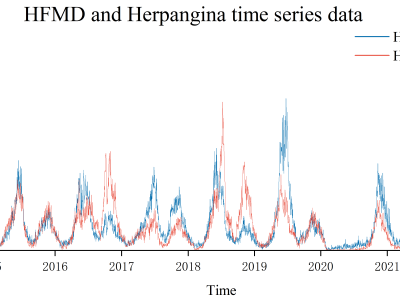Daily case number of HFMD and herpangina and climate information of Chongqing city, China, form 2015 to 2021

- Citation Author(s):
- Submitted by:
- Yao Hailun
- Last updated:
- DOI:
- 10.21227/d418-jf96
- Data Format:
- Links:
 218 views
218 views
- Categories:
- Keywords:
Abstract
The daily case data for HFMD (Hand-Foot-and-Mouth Disease) and herpangina were collected from the Children’s Hospital of Chongqing Medical University, a national clinical medical research center of China, spanning from January 1, 2015, to December 31, 2021. This dataset contains the timestamp of each patient's discharge, resulting in a total of 109,096 records for HFMD and 133,869 records for herpangina.
Furthermore, daily meteorological data for the same time frame, covering the period from January 1, 2015, to December 31, 2021, were obtained from the 'Weather in the World' website (https://rp5.ru/Weather_in_the_world). This meteorological dataset primarily comprises the following variables: average temperature (tem avg), maximum temperature (tem h), minimum temperature (tem l), atmospheric pressure at the meteorological station (alws), mean sea level atmospheric pressure (mslap), and relative humidity (rh).
All of these variables exhibit strong correlations with our target variable, HFMD, and thereby contribute significantly to HFMD prediction."
Instructions:
In our work, we are primarily interested in HFMD (Hand-Foot-and-Mouth Disease). Therefore, in our experiments, our primary focus is on predicting HFMD. The ultimate prediction target is only HFMD, while the inputs consist of all variables, including the daily case data for HFMD and herpangina, meteorological data such as average temperature (tem avg), maximum temperature (tem h), minimum temperature (tem l), atmospheric pressure at the meteorological station (alws), mean sea level atmospheric pressure (mslap), and relative humidity (rh).
Readers can also explore other prediction tasks, such as multivariate prediction and univariate prediction.







